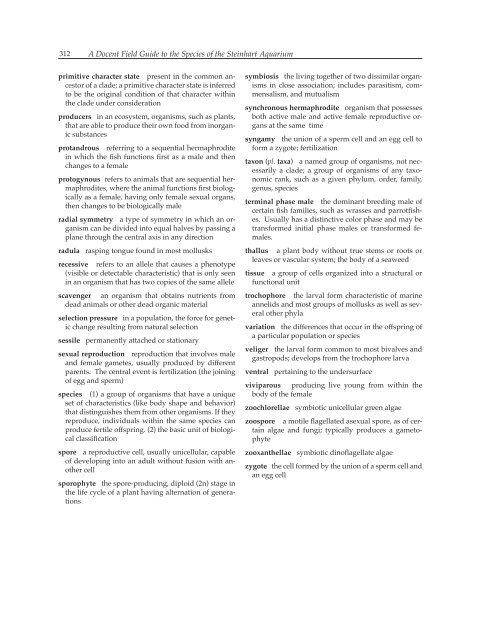THE STEINHART AQUARIUM - Gulf of Guinea Science ...
THE STEINHART AQUARIUM - Gulf of Guinea Science ...
THE STEINHART AQUARIUM - Gulf of Guinea Science ...
You also want an ePaper? Increase the reach of your titles
YUMPU automatically turns print PDFs into web optimized ePapers that Google loves.
312<br />
A Docent Field Guide to the Species <strong>of</strong> the Steinhart Aquarium<br />
primitive character state present in the common ancestor<br />
<strong>of</strong> a clade; a primitive character state is inferred<br />
to be the original condition <strong>of</strong> that character within<br />
the clade under consideration<br />
producers in an ecosystem, organisms, such as plants,<br />
that are able to produce their own food from inorganic<br />
substances<br />
protandrous referring to a sequential hermaphrodite<br />
in which the fish functions first as a male and then<br />
changes to a female<br />
protogynous refers to animals that are sequential hermaphrodites,<br />
where the animal functions first biologically<br />
as a female, having only female sexual organs,<br />
then changes to be biologically male<br />
radial symmetry a type <strong>of</strong> symmetry in which an organism<br />
can be divided into equal halves by passing a<br />
plane through the central axis in any direction<br />
radula rasping tongue found in most mollusks<br />
recessive refers to an allele that causes a phenotype<br />
(visible or detectable characteristic) that is only seen<br />
in an organism that has two copies <strong>of</strong> the same allele<br />
scavenger an organism that obtains nutrients from<br />
dead animals or other dead organic material<br />
selection pressure in a population, the force for genetic<br />
change resulting from natural selection<br />
sessile permanently attached or stationary<br />
sexual reproduction reproduction that involves male<br />
and female gametes, usually produced by different<br />
parents. The central event is fertilization (the joining<br />
<strong>of</strong> egg and sperm)<br />
species (1) a group <strong>of</strong> organisms that have a unique<br />
set <strong>of</strong> characteristics (like body shape and behavior)<br />
that distinguishes them from other organisms. If they<br />
reproduce, individuals within the same species can<br />
produce fertile <strong>of</strong>fspring. (2) the basic unit <strong>of</strong> biological<br />
classification<br />
spore a reproductive cell, usually unicellular, capable<br />
<strong>of</strong> developing into an adult without fusion with another<br />
cell<br />
sporophyte the spore-producing, diploid (2n) stage in<br />
the life cycle <strong>of</strong> a plant having alternation <strong>of</strong> generations<br />
symbiosis the living together <strong>of</strong> two dissimilar organisms<br />
in close association; includes parasitism, commensalism,<br />
and mutualism<br />
synchronous hermaphrodite organism that possesses<br />
both active male and active female reproductive organs<br />
at the same time<br />
syngamy the union <strong>of</strong> a sperm cell and an egg cell to<br />
form a zygote; fertilization<br />
taxon (pl. taxa) a named group <strong>of</strong> organisms, not necessarily<br />
a clade; a group <strong>of</strong> organisms <strong>of</strong> any taxonomic<br />
rank, such as a given phylum, order, family,<br />
genus, species<br />
terminal phase male the dominant breeding male <strong>of</strong><br />
certain fish families, such as wrasses and parrotfishes.<br />
Usually has a distinctive color phase and may be<br />
transformed initial phase males or transformed females.<br />
thallus a plant body without true stems or roots or<br />
leaves or vascular system; the body <strong>of</strong> a seaweed<br />
tissue a group <strong>of</strong> cells organized into a structural or<br />
functional unit<br />
trochophore the larval form characteristic <strong>of</strong> marine<br />
annelids and most groups <strong>of</strong> mollusks as well as several<br />
other phyla<br />
variation the differences that occur in the <strong>of</strong>fspring <strong>of</strong><br />
a particular population or species<br />
veliger the larval form common to most bivalves and<br />
gastropods; develops from the trochophore larva<br />
ventral pertaining to the undersurface<br />
viviparous producing live young from within the<br />
body <strong>of</strong> the female<br />
zoochlorellae symbiotic unicellular green algae<br />
zoospore a motile flagellated asexual spore, as <strong>of</strong> certain<br />
algae and fungi; typically produces a gametophyte<br />
zooxanthellae symbiotic din<strong>of</strong>lagellate algae<br />
zygote the cell formed by the union <strong>of</strong> a sperm cell and<br />
an egg cell


